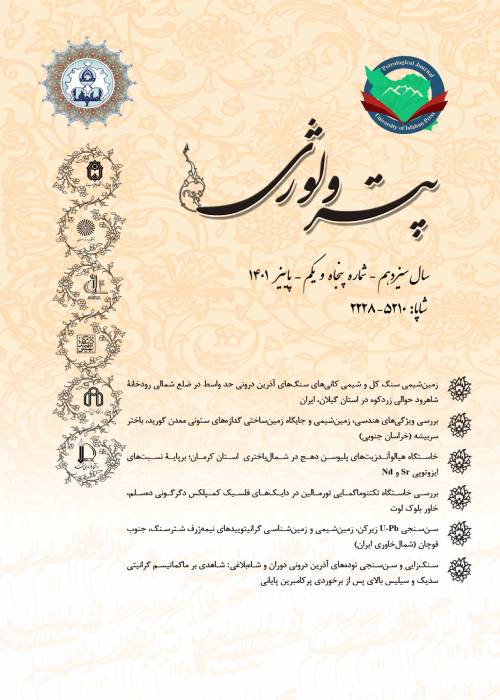Geochemistry of tourmaline in granitoids and metamorphic rocks of Qohroud-Qamsar, Kashan, Central Iran
Tourmaline is an indicator mineral of pegmatite, granites and pneumatolytic veins. In metamorphic rocks, it is formed by the process of boron metasomatism and in sediments by the recrystallization of destructive particles. This mineral crystallizes in various temperatures, pressures and geological environments so can be widely used in lithological studies.The study areas are part of the geological map of Kashan located in the west of the volcanic belt of Central Iran (Urmia-Dokhtar belt). A number of studies have been carried out regarding the geological and petrological of the areas of study: Among those, petrology and geological studies of metamorphic aureole in Qohroud granitoid (Ahankoub, 2003), petrography and petrology of Qohroud plutonic rocks (Jafari, 2001), the type of garnet zoning in skarns of Qohroud Intrusion (Farazdel et al., 2005) and geochemistry and petrology of mafic-intermediate intrusions in mineralized region of Qamsar, Kashan Yar-Ali (2016) are more notable. The purposes of the present study are to determine the origin of tourmalines from the study areas on the base of their petrographic and geochemical characteristics as well as their structural formula and to compare these minerals as well.
Following field observations, 25 thin sections were prepared for mineralogical and textural studies using Olympus polarizing microscope (BH2). 10 samples of tourmalines were analzyed by XPM analysis at Binalood Company. The results of microprobe analyses of tourmalines from hornfelses (Ahankoub, 2003) carried out at the Oklahoma University (USA) were also used for the present study. All these data are given in Tables 1 and 2.
The areas under investigation are predominantly compose of sedimentary, metamorphic (hornfels, marble, skarn) and intrusive (granodiorite, monzogranite, tonalite) rocks. Plagioclase, orthoclase, quartz, hornblende, and biotite as major with sphene, zircon, tourmaline and opaque as minor minerals are dominant. Tourmalines in these areas are metasomatism in nature and as needles and small crystals. are mainly found in fractures. Tourmaline crystals with zoning, formed in post-crystallization and hydrothermal stages, were subjected to influence of boron-rich solutions presumably point to mixing of fluids in open systems. Green tourmalines replaced feldspars possibly caused by tourmalinization in the pneumatolitic stage by reactions of boron with wall rocks.Based on X position and Ca, Na, K contents, most of tourmalines are alkaline. The chemical composition of tourmaline in hornfels is mainly dravite and in granitoids is dravite with a tendency towards schorlite. The formation of tourmaline instead of biotite and chlorite in metamorphic rocks shows the its formation as a result of reactions of boron fluids with aluminosilicates. The studied tourmalines lie below the line and therefore, have Al substitution in the Y position. As the Fe-Mg-Ca and Al-Mg-Fe diagrams display these tourmalines are mainly plotted within the metapelites and metapesamites in calcium poor quartz- tourmaline rocks. The ratio of FeO / FeO + MgO tourmalines from the hornfels is between 0.58 to 0.6 (ave. 0.59), which confirms they have crystallized in an open magmatic system with the presence of boron with an external origin and indicates the involvement of atmospheric water during their formation in the hydrothermal system. This ratio in tourmalines from the granitoids are between 0.56 to 0.69 (ave. 0.63), which can indicate the formation of these tourmalines during the mixing of magmatic and hydrothermal fluids.
The chemical composition of the studied tourmalines based on cationic substitutions is in the range of alkaline tourmalines, which indicates a higher amount of K and Na at position X compared to Ca and confirm their formation in acidic and low temperature conditions. The chemical composition of tourmalines from granitoids is in the range of dravite and schorlite and the chemical composition of tourmalines from hornfels are mainly dravite, which represents the cation exchanges of Fe, Mg in constant values of Ca and Al. The studied tourmalines are located in the range of calcium-poor metapelites and metapsamites and calcium-poor quartz-tourmaline rocks and coexist with the aluminum-saturated phase. Based on the amount of FeO / FeO + MgO in tourmalines, the openness of the system and the presence of boron from an external source is confirmed.
granitoid , Tourmaline , Qohroud , Qamsar , Urumieh-Dokhtar
- حق عضویت دریافتی صرف حمایت از نشریات عضو و نگهداری، تکمیل و توسعه مگیران میشود.
- پرداخت حق اشتراک و دانلود مقالات اجازه بازنشر آن در سایر رسانههای چاپی و دیجیتال را به کاربر نمیدهد.


